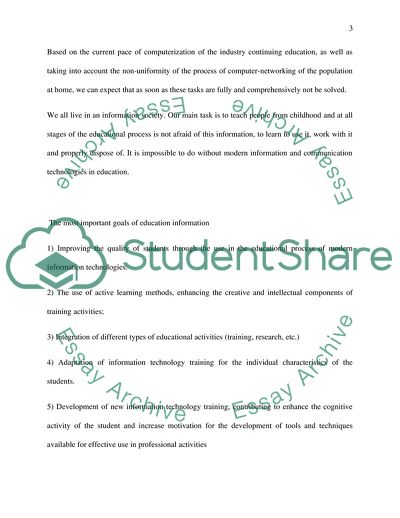Cite this document
(Information and Communication Technologies Are Increasingly Used in Essay Example | Topics and Well Written Essays - 2000 words, n.d.)
Information and Communication Technologies Are Increasingly Used in Essay Example | Topics and Well Written Essays - 2000 words. https://studentshare.org/education/1833981-information-and-communication-technologies-icts-are-increasingly-used-in-university-education-critically-evaluate-claims-that-these-technologies-enhance-learning-in-ways-traditional-methods-cannot
Information and Communication Technologies Are Increasingly Used in Essay Example | Topics and Well Written Essays - 2000 words. https://studentshare.org/education/1833981-information-and-communication-technologies-icts-are-increasingly-used-in-university-education-critically-evaluate-claims-that-these-technologies-enhance-learning-in-ways-traditional-methods-cannot
(Information and Communication Technologies Are Increasingly Used in Essay Example | Topics and Well Written Essays - 2000 Words)
Information and Communication Technologies Are Increasingly Used in Essay Example | Topics and Well Written Essays - 2000 Words. https://studentshare.org/education/1833981-information-and-communication-technologies-icts-are-increasingly-used-in-university-education-critically-evaluate-claims-that-these-technologies-enhance-learning-in-ways-traditional-methods-cannot.
Information and Communication Technologies Are Increasingly Used in Essay Example | Topics and Well Written Essays - 2000 Words. https://studentshare.org/education/1833981-information-and-communication-technologies-icts-are-increasingly-used-in-university-education-critically-evaluate-claims-that-these-technologies-enhance-learning-in-ways-traditional-methods-cannot.
“Information and Communication Technologies Are Increasingly Used in Essay Example | Topics and Well Written Essays - 2000 Words”. https://studentshare.org/education/1833981-information-and-communication-technologies-icts-are-increasingly-used-in-university-education-critically-evaluate-claims-that-these-technologies-enhance-learning-in-ways-traditional-methods-cannot.


